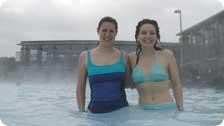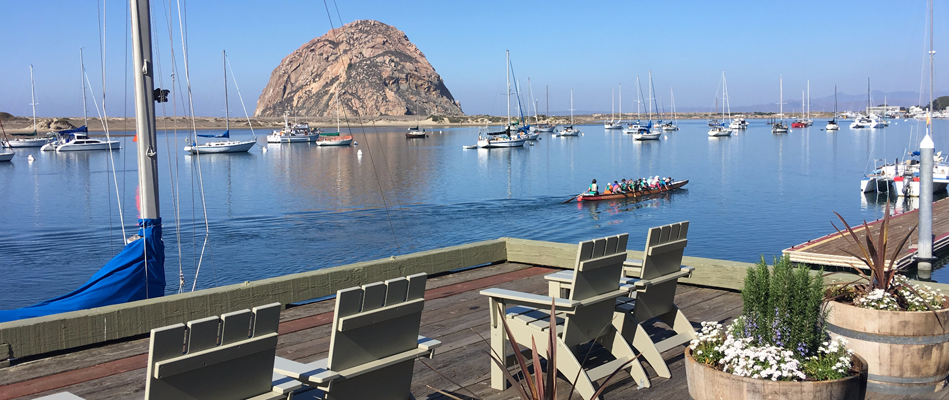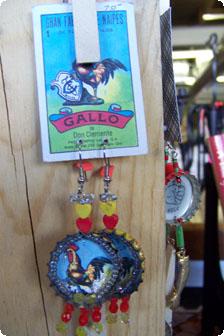by Gloria Fallon
My friend Patty and I didn’t say much as we loaded our luggage into the rental car at Keflavik Airport. We’d just landed in Iceland, and already we were silenced by the landscape. “It looks like we’ve landed on Mars,” Patty finally said as we took it all in.
Since we met during our junior year abroad in London, Patty and I had traveled extensively through Europe together—from the canals of Venice and Amsterdam to the mountains of Austria and Italy—but we’d never seen anything like Iceland.
The surrounding lava field resembled a movie set for an outer space film, with huge moss-covered rocks haphazardly heaped on the ground, and funnels of steam rising to meet low-lying gray clouds in the distance. It was a formidable and alien landscape with no trees, no grass and no shrubs. We’d heard that the Apollo 11 crew practiced moon walking in Iceland, and now we could see why.
With the suspiciously simple verbal directions given by the rental car clerk—“Just follow the road to Reykjavik”—we headed towards the capital city. The clerk wasn’t kidding. There was literally one road out of the parking lot with a sign pointing to Reykjavik. Despite the barren landscape of volcanic rock that welcomed us, we were already warming to Iceland.
Iceland has the reputation of being a remote country, but it’s actually North America’s closest European neighbor, located relatively halfway between the U.K. and the U.S. There are many misconceptions about Iceland, and surely the name of the country doesn’t help any. Far from freezing or being covered in ice, Iceland has a relatively mild climate, averaging 60 degrees in the summer and 32 in the winter. We were visiting in April, and the temperature during our stay was around 40 degrees, requiring a winter jacket, but far from scarf-and gloves-weather.
Jumping on the tourist bandwagon, our first trip was to Iceland’s largest tourist attraction—the Blue Lagoon. The directions we received from our hotel’s concierge sounded vaguely familiar—“Follow signs for ‘The Blue Lagoon.’” We drove through ugly lava fields but were getting closer to the wisps of rising steam we had seen from the airport. Suddenly the Blue Lagoon appeared, providing a visual thrill of electric sky-blue water in dramatic contrast with the surrounding black craggy lava hills. If the moon had lakes, I imagine they would look like the Blue Lagoon.
Soaking and swimming in the lagoon for three luxurious hours was an experience all its own. The air was a crisp 40 degrees, the milky blue water was 100. The steaming water was incredibly relaxing, and packed with mineral salts, silica and algae that are supposedly responsible for its famous healing powers. You won’t find any native Icelanders here—they prefer to hang out in Reykjavik’s seven other geothermal swimming pools.
Thoroughly relaxed and invigorated after the lagoon, Patty and I were ready to do some sightseeing. We opted to take a self-navigated Golden Circle tour, which showcases many of Iceland’s best-known natural wonders in the southwest. The scenery changed dramatically as we drove along with the audio tour. The lava fields gave way to a landscape resembling that of England—green and rolling glacial valleys, but harsher terrain, with more scrub.
In all my travels, I’ve never seen a geographic environment as diverse as Iceland’s—beautiful, sparse, welcoming, frightening, tame and wild—it’s all there on this tiny island.
Small cottages and farms peppered the valley, and herds of little stumpy Viking horses would occasionally cross the street. We soon reached our first stop at Kerio (pronounced Kerrith), a volcano that imploded 6,500 years ago, forming a crater that now has a lake in it. The water doesn’t drain, but instead changes in depth only from precipitation. The water was the color of a green-blue Crayola crayon, and the sloping side of the crater was rusty maroon, dotted with dark green foliage. I never knew a crater could be so beautiful.
The next big stop of the Golden Circle tour was Geysir (pronounced “Gay-sir”)—the place where the word “geyser” originated. Every eight minutes, a geyser named Strokur erupts, sending boiling water 20 meters into the air. That was an incredible experience as I’d never seen a geyser in action before. Patty had been to Yellowstone National Park, and she felt that even though Old Faithful reaches higher, the effect is lessened by the crowds and restricted areas.
Being an American who is accustomed to craning my neck behind roped-off exhibits, I was unnerved at first to see no guardrails anywhere—just small signs reminding visitors of the obvious need to stand back from the geysers. Iceland, especially the parts that aren’t frequented by tourists, is truly an “At Your Own Risk” country. You can walk right up to a geyser, swim under a waterfall, scramble up a mountainside and nobody will stop you. Granted, it may be the last thing you do on this earth, but those with common sense can experience and enjoy the outdoors unimpeded by guardrails, velvet ropes, or plexi-glass barriers.
After Geysir, we arrived at the highlight of the Golden Circle Tour: Gulfoss, the Golden Waterfall. On a sunny day, a rainbow forms over the waterfall from the mist rising. We were there on a cloudy day, so we didn’t get a rainbow, but it was still magnificent to watch the rushing water fall 105 feet into a mile-and-a-half-wide ravine. Once again, we were the only people there—free to watch for as long as we liked, free to stand as close as we felt was safe.
After all our sightseeing during the day, Patty and I made sure we hit the town once the sun set. As widely reported, the nightlife in Reykjavik is among Europe’s liveliest. There are more bars, clubs and cafés in Reykjavik than any city I’ve ever visited, and our favorites were Solon, Dubliners, Kaffibarinn, and Nelly’s.
Many of the descriptions I’d heard about Reykjavik nightlife made it sound intimidating—describing it as some high fashion, techno-party parade led by gorgeous Nordic girls, but I didn’t find this was the case at all. Everyone was just out for a good time, and Patty and I fit in just fine. Not that there weren’t plenty of gorgeous, well-dressed blondes around, but brunettes wearing Banana Republic shouldn’t be discouraged.
It was in the city’s bars and cafés that we met many native Icelanders who all speak English as well as Icelandic and Dutch. Gregarious and fun loving, they are also socially, culturally and politically aware. Everyone Patty and I met was interested in hearing about America and America’s perception of Iceland.
Icelanders are also perhaps the friendliest people on earth. More than once, we were approached by Icelanders who recognized us as tourists, as we took pictures and looked at maps, and wished us an enjoyable stay. When we went out to bars, we’d see more hugs and kisses than at a family reunion—the bar scene in Reykjavik reminded me of one big “Cheers.” I think Patty summed it up best when she said, “Visiting Iceland is like coming over to see 200,000 of your best friends.”
Our trip was coming to an end, but neither of us was ready to leave. We had packed our days with sightseeing, but there was still so much more of Iceland’s unique terrain that we wanted to tour. We had a stack of email addresses and cell phone numbers from Icelanders we had met out in Reykjavik, and we felt like we were leaving a group of friends.
Five days were simply not enough to spend in this wondrous, welcoming and warm country. On our last day, we reluctantly drove our little rental car back to the airport in Keflavik, this time unable to stop talking about plans for our next trip to Iceland.
About the Author:
Gloria is a travel and humor writer and co-author of the humor book, “I Hate This Place: The Pessimist’s Guide to Life,” published by Warner Books in 2003. An anglophile since studying abroad in London, she frequently travels to Europe with her British husband Ian to visit in-laws in England and France. Her writing has also appeared in Jane, New York Magazine, amNew York, Platinum, and the Boston Phoenix as well as numerous websites including McSweeney’s.net and The New Colonist.













